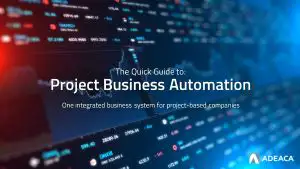Choosing ERP software is likely one of the most important projects your company will take on, and, believe it or not, is a strategic move that should be led by the CEO and not delegated entirely to the CIO. Selecting your next ERP system will set the framework for the success – or failure – of your business for the next 7 to 10 years.
The right Enterprise Resources Planning (ERP) system can streamline your company’s business processes, enhance efficiency, reduce risk and improve the bottom line. Aren’t these things a CEO should take heed of?
That’s why it’s critical to handle the ERP selection process correctly so you can ensure the system will enable your business to be agile, profitable and operate more efficiently now and in the future.
As CEO, you should be intimately involved in the ERP selection process and lead it from the top down as a strategic initiative. Here are some common mistakes we have seen CEOs make when selecting their ERP systems and how to avoid them.
1) Not prioritizing your business requirements based on their impact on long-term shareholder value
Too often companies lead the ERP process with a set of technical requirements, but successful implementations are a result of defining the proper business requirements up front. As CEO you must start by identifying the goals you want to achieve over the next several years that will improve shareholder value:
- Serving your customers better
- Gaining a competitive advantage
- Increasing profitability
- Optimizing cash flow
- Improving agility by adjusting faster to market changes
The outcome of this exercise leads to a long list of requirements that you need to prioritize according to the impact on long-term shareholder value. It’s a breakdown – not a buildup exercise.
2) Not staffing your selection group to meet your long-term business goals
Too often software selection groups are organized to establish broad representation across the entire organization, rather than ensuring competent and dedicated focus on the requirements that are designed to solve their companies’ future business needs.
The selection group has to possess the qualifications necessary to validate the potential ERP solutions against the key requirements, and the group’s composition and structure must acknowledge the fact that some requirements have far greater impact on the company’s long-term shareholder value than others.
Also, be careful not to underestimate the internal resource requirements. Depending on the size of your organization, you should expect the the full project cycle to require at least 2 to 3 full-time dedicated staff.
Finally, as CEO you can’t leave all the significant ERP decisions to the selection group. If your ERP project is going to succeed, you have to take the lead, and you also have to let everyone in your company know the importance of the project.
3) Not getting the most out of the resources you invest in the selection process
Identify your preferred vendor as early as possible. Don’t spend your resources on completing rigid processes with numerous vendors. Instead pick one vendor early in the process and enter a deep conversation with them. Most any vendor will have massive experience from hundreds of similar projects from which you can learn and benefit. Take advantage of that and remember to ask them to challenge you.
4) Not properly vetting the solution your team recommends
You need to ensure that the ERP software your team recommends will be able to provide the intelligence you need to run and optimize your business.
You must ensure that:
- The solution will be able to provide you with real-time insight with inputs from your entire organization
- You are buying a single solution – not a mashup of components – or you will never be able to obtain real-time insight
- You are not buying slideware (promised functionality to come in future releases or extensive customization that could take years).
5) Not focusing on the business case
Many companies focus too heavily on cost when they select their ERP solutions. While budget is critical, it’s not the only factor that should play a role in your decision. Instead, your selection group should prepare a solid business case as part of their recommendation. The business case should include:
An assessment. Examine the current level of performance. Create baseline key performance indicators that articulate how key capabilities are currently performing.
Setting targets. After benchmarking key capabilities to see how they measure up, establish target levels of performance you would like to achieve.
Prioritization. Determine the steps in the ERP selection and implementation process to exploit value in the right sequence.
6) Not considering the cloud
Companies that decide not to move their ERP to the cloud typically pay a vendor more in ERP implementation and ongoing costs – not to mention the internal resource time spent on implementation and infrastructure operations and maintenance. Even after spending all the time and money setting up an on-premises system, it is much more likely this system will fail than one in the cloud. You cannot achieve the redundancy and fault tolerance in-house that you can in the cloud.
Many companies also site security as a reason they don’t move to the cloud. However, most all security data breaches occur from in-house systems and hardware. Cloud infrastructure can be just as, and in most cases is more secure than an on-site setup.
Deploying ERP in the cloud means you don’t need any additional hardware, so you don’t have to spend time and money buying and installing IT infrastructure. Plus, cloud deployments become operational expenses rather than capital expenditures, so it becomes a predictable monthly expense rather than a long-term budgeting exercise.
Finally, the cloud enables an easy and flexible rollout. It is much more cost effective and less operationally burdensome to introduce a cloud ERP across multiple geographies as well as subsidiaries and divisions.










